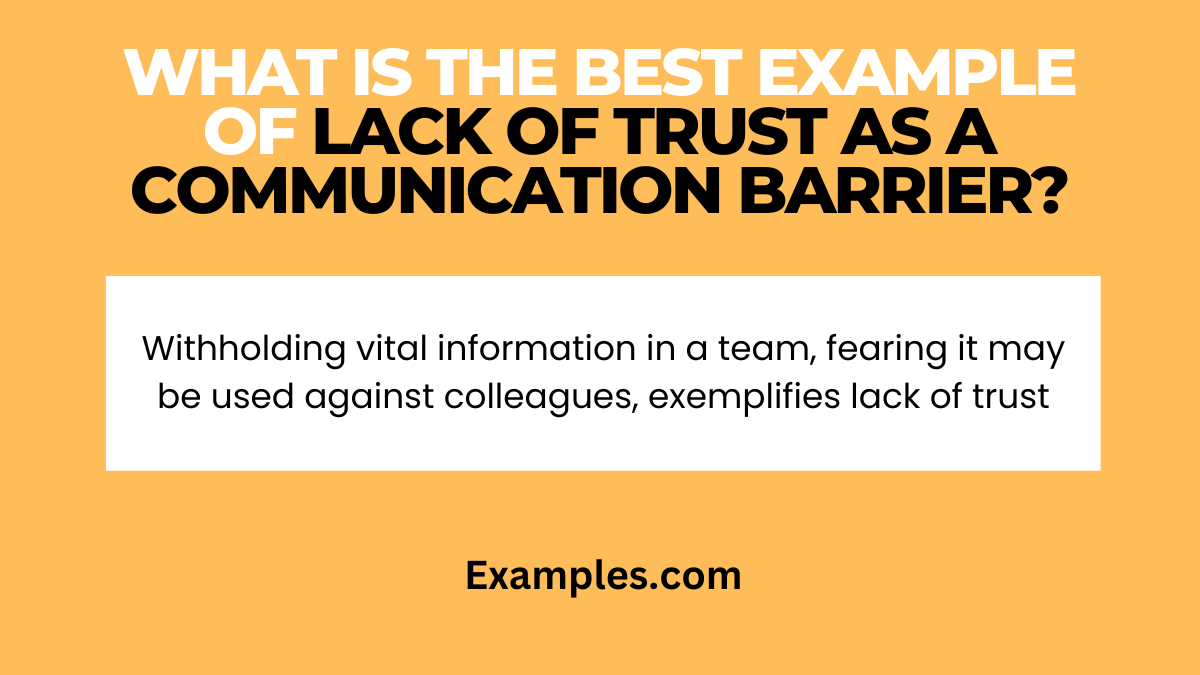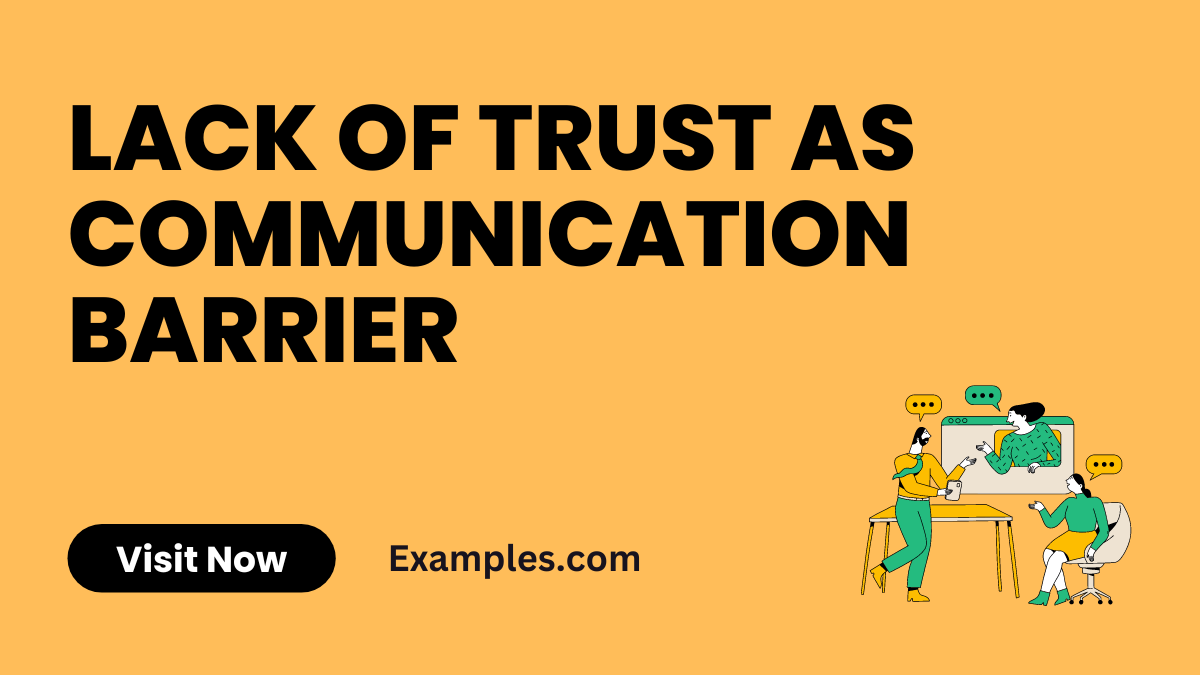19+ Lack of Trust as Communication Barrier Examples
Lack of Trust as a Communication Barrier is a significant obstacle in both personal and professional relationships. This barrier arises when mistrust or skepticism hampers open and honest communication, leading to misunderstandings, reduced cooperation, and overall inefficiency in interactions. Addressing this barrier is crucial for fostering a healthy communication environment, where trust and transparency lead to more meaningful and productive exchanges. Understanding the dynamics of trust can significantly enhance communication effectiveness.
What is Lack of Trust as a Communication Barrier?

Lack of Trust as a Communication Barrier occurs when doubt and skepticism overshadow the openness and honesty necessary for effective communication. This barrier can stem from past experiences, misunderstandings, or perceived inconsistencies in behavior or information. It leads to a reluctance to share information, misinterpretations, and a general breakdown in communication. Overcoming this barrier is essential for achieving clear, effective, and collaborative communication.
What is the Best Example of Lack of Trust as a Communication Barrier?

A classic example of Lack of Trust as a Communication Barrier is found in a team setting where members have experienced broken promises or inconsistent messages from leadership. This situation often leads to team members withholding information, second-guessing decisions, and reduced collaboration, significantly impacting team dynamics and productivity. Addressing and rebuilding trust becomes imperative to restore effective communication and teamwork.
20 Examples of Lack of Trust as Communication Barrier

Lack of Trust as a Communication Barrier can manifest in various forms, impacting personal and professional relationships. These examples demonstrate how trust issues can lead to communication breakdowns, misunderstandings, and ineffective interactions. Each example provides insight into the different ways lack of trust can affect communication and offers potential ways to address these challenges for better understanding and collaboration.
- Hesitation to Share Ideas in a Team Meeting: Fear that ideas will be stolen or undervalued.
Example: “I’m not sure if I should share my idea here.” - Avoiding Open Feedback in Performance Reviews: Concern about receiving biased or unfair criticism.
Example: “I doubt the feedback I receive will be objective.” - Resisting Change Initiatives in Organizations: Distrust in management’s intentions or capabilities.
Example: “I’m not convinced this change is for our benefit.” - Ignoring Advisories in Health Care Settings: Skepticism towards medical advice or treatments.
Example: “I don’t trust this treatment will work.” - Reluctance to Engage in Therapeutic Communication: Doubting the therapist’s confidentiality or expertise.
Example: “I’m not sure I can trust you with my problems.” - Disregarding Instructions from Authority Figures: Mistrust in leadership or authority.
Example: “I don’t believe they have our best interests at heart.” - Withholding Information in Relationships: Fear of judgment or betrayal.
Example: “I can’t tell them; they might not understand.” - Resistance to Collaborate in Group Projects: Doubting team members’ commitment or skills.
Example: “I’ll just do it myself; I can’t rely on them.” - Refraining from Seeking Help or Support: Concern about being seen as weak or incompetent.
Example: “I don’t want them to think I can’t handle it.” - Ignoring Constructive Criticism: Perceiving feedback as personal attacks.
Example: “They’re just trying to criticize me, not help.” - Avoiding Vulnerability in Personal Conversations: Fear of being hurt or misunderstood.
Example: “I can’t share my feelings; they might use them against me.” - Rejecting New Opportunities for Growth: Distrust in the genuineness of the opportunity.
Example: “This opportunity seems too good to be true.” - Doubting the Authenticity of Compliments: Perceiving praise as insincere or manipulative.
Example: “They’re just saying that; they don’t mean it.” - Withdrawing from Social Interactions: Mistrust in others’ intentions in social settings.
Example: “I don’t want to join; they probably don’t want me there.” - Questioning the Reliability of Information: Skepticism towards news or data sources.
Example: “I don’t believe this information is accurate.” - Refusing to Delegate Tasks: Lack of trust in others’ ability to handle responsibilities.
Example: “I need to do it myself to ensure it’s done right.” - Misinterpreting Non-Verbal Cues: Assuming negative intentions behind body language.
Example: “Their body language seems off; they must be hiding something.” - Avoiding Commitments in Relationships: Fear of being let down or disappointed.
Example: “I can’t commit; they might not stick around.” - Ignoring Safety Advisories in Public Settings: Distrust in public safety announcements or guidelines.
Example: “I don’t think these safety warnings are necessary.” - Skepticism Towards Online Transactions: Fear of fraud or misuse of personal information.
Example: “I don’t trust making payments online; it’s too risky.”
Recognizing and addressing these instances of Lack of Trust as a Communication Barrier is vital for rebuilding trust and improving communication efficiency and effectiveness in various contexts.
Lack of Trust as Communication Barrier in the Workplace
In the workplace, Lack of Trust can significantly impede effective communication, leading to reduced collaboration, misinterpretation of information, and a decline in team morale. This barrier often arises from past experiences, inconsistent behavior, or perceived untruthfulness, causing employees to withhold information, resist change, and question leadership decisions.
- Withholding Information Due to Fear of Misuse: Employees may not share ideas, fearing their misuse or misappropriation.
- Reluctance to Accept Feedback: Distrust in motives can lead to resistance against constructive feedback.
- Hesitation in Reporting Issues: Concerns about negative repercussions may prevent open reporting of problems.
- Resistance to Change Initiatives: Skepticism about the intent and outcome of changes.
- Gossip and Rumor Spreading: Mistrust fosters a culture of gossip, harming team dynamics.
- Questioning Leadership Decisions: Doubting the integrity and intentions of management.
- Avoiding Collaboration: Preferring to work alone due to distrust in team members.
- Lack of Participation in Team Activities: Withdrawal from team events and meetings.
- Reduced Innovation and Creativity: Fear of ideas being stolen or not valued.
- Doubting the Authenticity of Praise or Recognition: Perceiving positive feedback as insincere or manipulative.
Lack of Trust as Communication Barrier in Real Life
In personal relationships, Lack of Trust can lead to misunderstandings, conflicts, and a breakdown in communication. It often stems from past experiences, inconsistencies in actions or words, and general skepticism, making open and honest dialogue challenging.
- Misinterpreting Intentions in Conversations: Doubting the sincerity behind words or actions.
- Reluctance to Share Personal Feelings: Hesitating to open up due to fear of judgment or betrayal.
- Avoiding Deep or Meaningful Conversations: Keeping conversations superficial to avoid vulnerability.
- Withholding Support in Times of Need: Not offering help, suspecting ulterior motives.
- Difficulty in Building New Relationships: Challenges in forming new connections due to past trust issues.
- Assuming Deception in Responses: Perceiving dishonesty in even truthful communications.
- Lack of Confidence in Commitments: Doubting the reliability of others’ promises or commitments.
- Resisting Advice or Suggestions: Disregarding guidance due to mistrust in the advisor.
- Interpersonal Conflicts Based on Suspicion: Conflicts arising from doubts and suspicions.
- Limited Social Interactions and Networking: Withdrawing from social events due to mistrust in others.
Addressing Lack of Trust in both workplace and personal settings is vital for healthy and effective communication. Recognizing these barriers and actively working to build trust can lead to more positive and constructive interactions.
How Does Lack of Trust Affect Communication?
Lack of Trust significantly affects communication, creating barriers that can impede understanding, collaboration, and the overall effectiveness of interactions. When trust is missing in any form of communication, it leads to a range of issues that can disrupt both personal and professional relationships.
- Reduced Openness and Honesty: Without trust, individuals are less likely to be open and honest in their communication.
- Increase in Misunderstandings: Distrust leads to assumptions and misinterpretations, affecting the clarity of messages.
- Decreased Collaboration and Teamwork: In a team setting, lack of trust hinders the willingness to collaborate effectively.
- Resistance to Change and New Ideas: People are less likely to accept changes or new ideas from sources they don’t trust.
- Heightened Conflict and Tension: Distrust can escalate conflicts and create a tense communication environment.
- Lower Morale and Engagement: Continuous distrust can lead to disengagement and low morale among team members or partners.
- Impaired Decision Making: Distrust in information or sources can lead to poor decision-making processes.
- Stifled Personal and Professional Growth: In an environment where trust is lacking, personal and professional growth is often limited, as individuals may not receive or accept constructive feedback or support.
Understanding and addressing the Lack of Trust as a communication barrier is crucial for restoring effective communication and rebuilding relationships in both personal and professional contexts.
Addressing the Lack of Trust as a Communication Barrier is essential for fostering effective and meaningful interactions. Whether in personal relationships, the workplace, or broader social contexts, building and maintaining trust is crucial for clear and constructive communication. This guide highlights the significance of trust and offers insights into overcoming trust-related barriers, paving the way for improved understanding, collaboration, and relationship-building.



